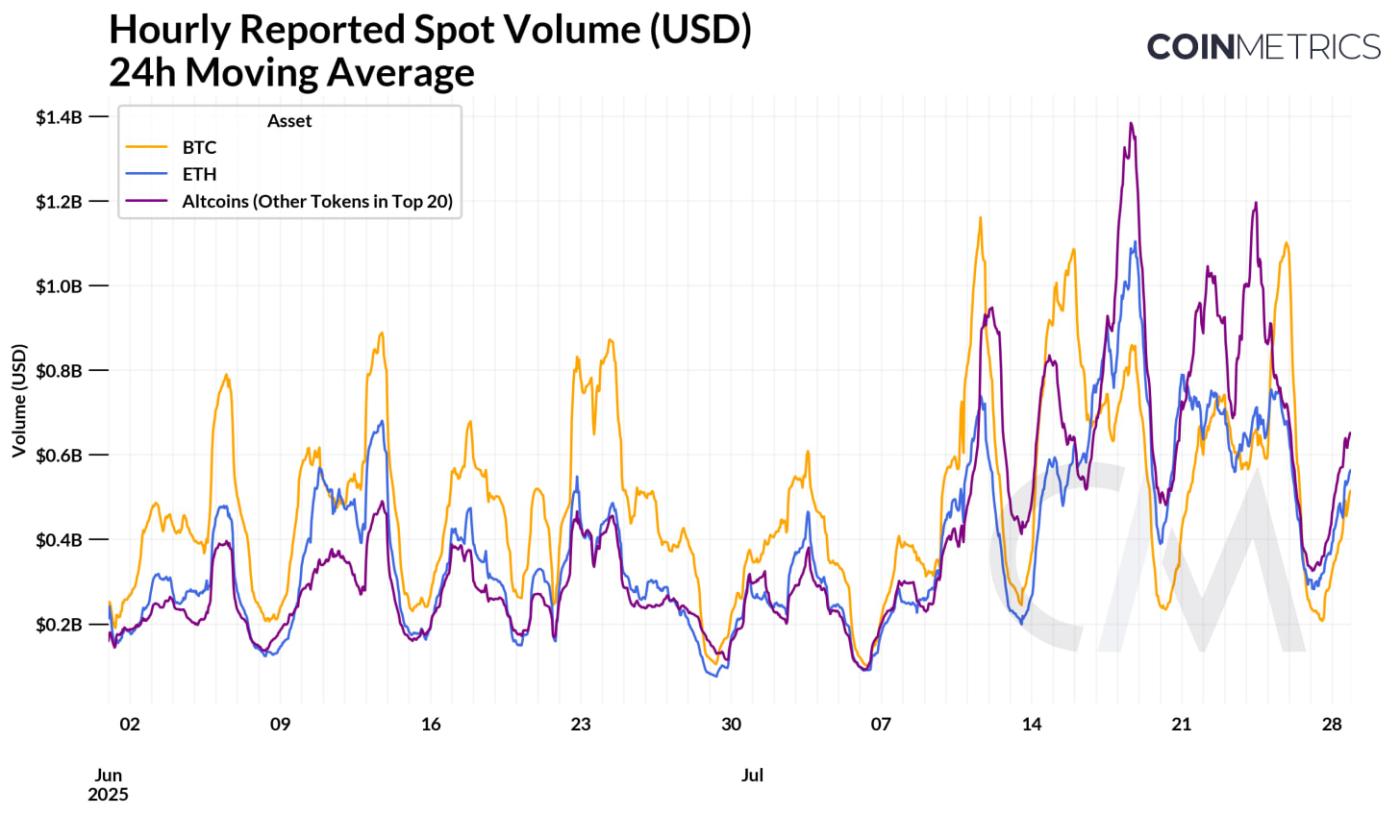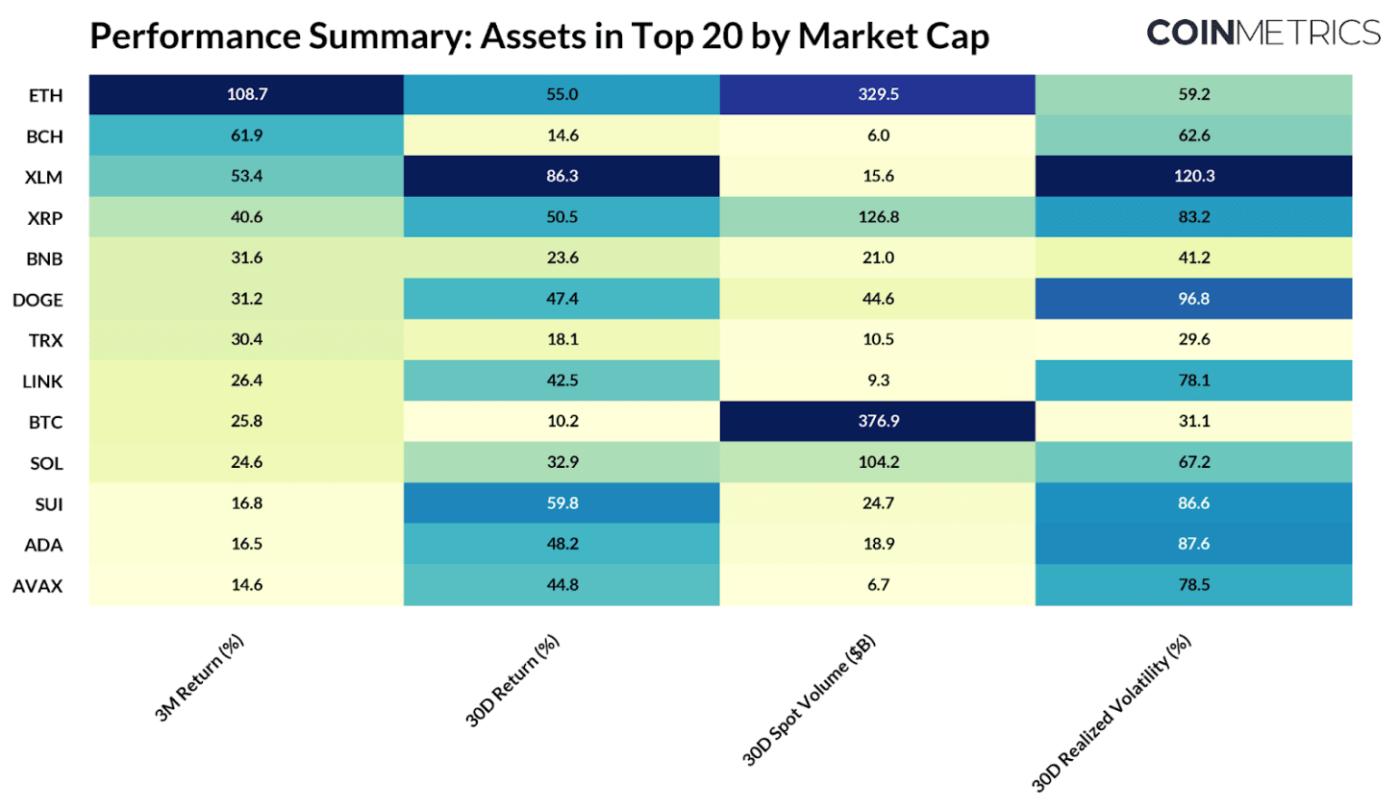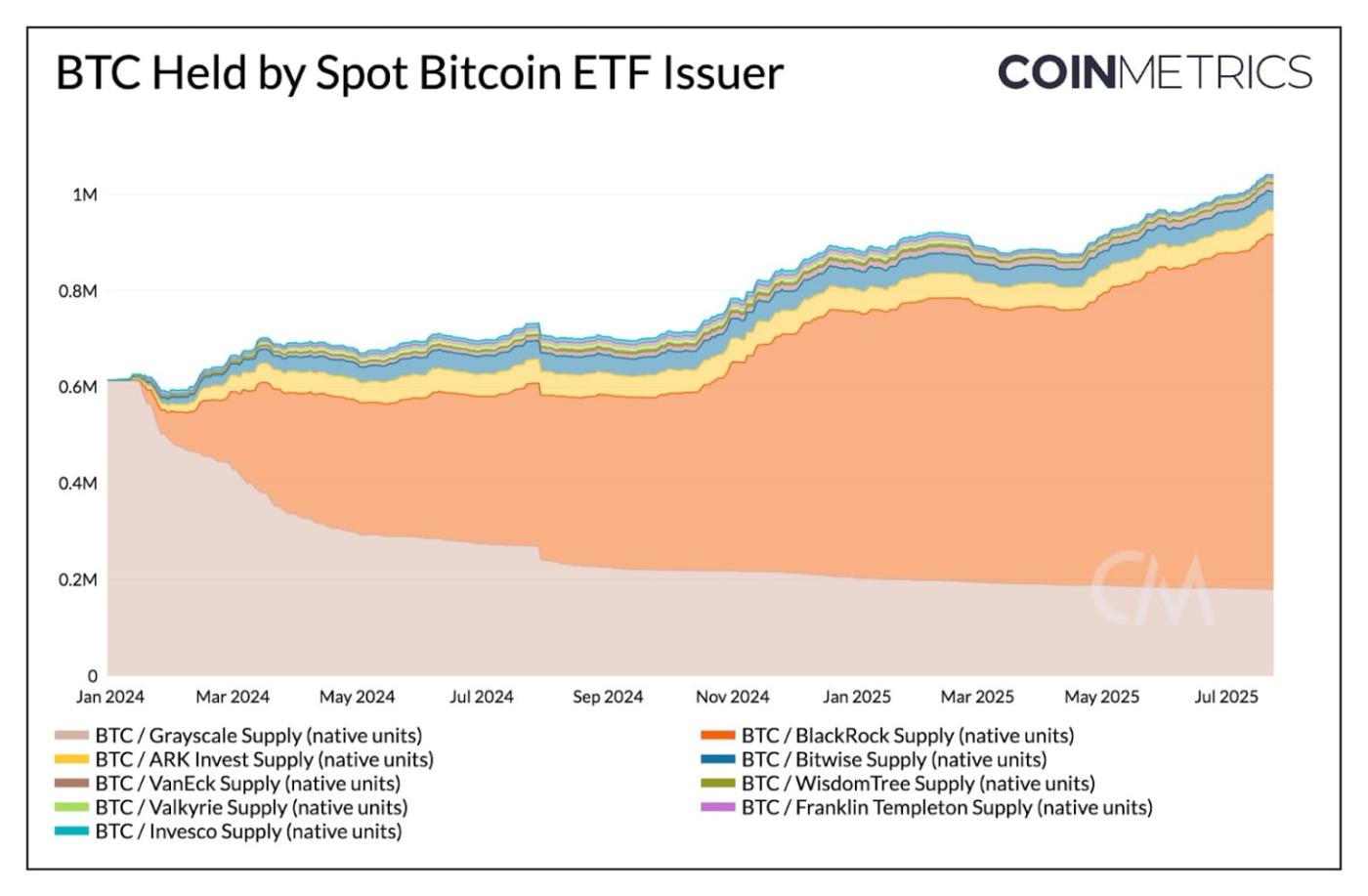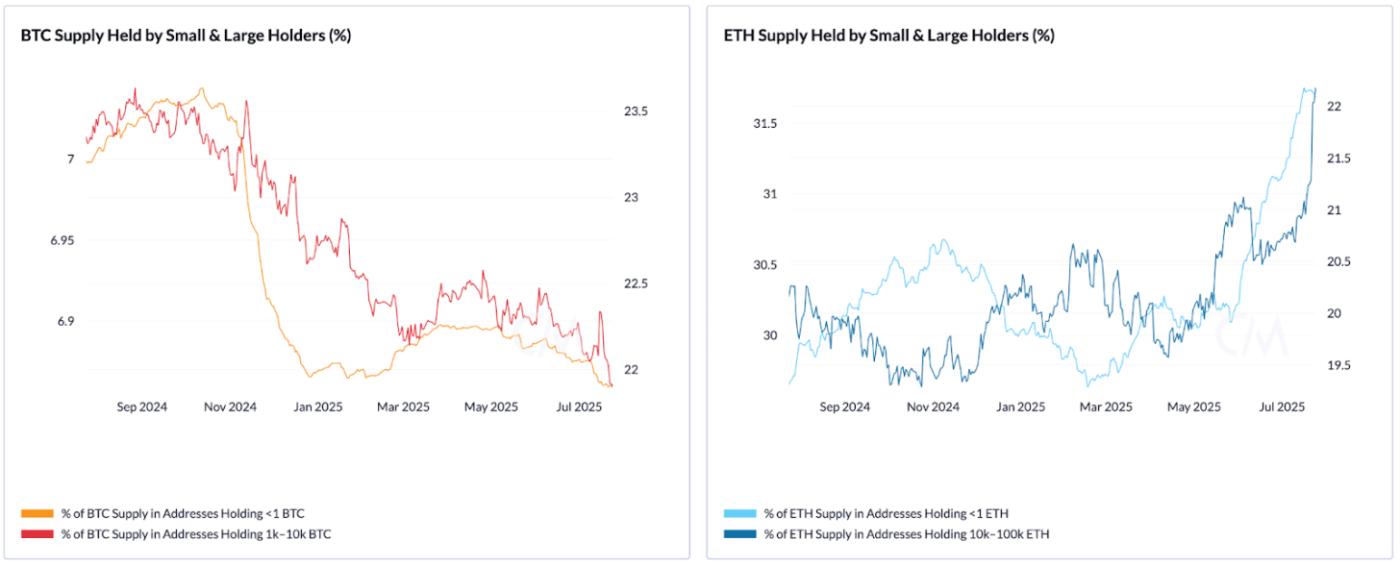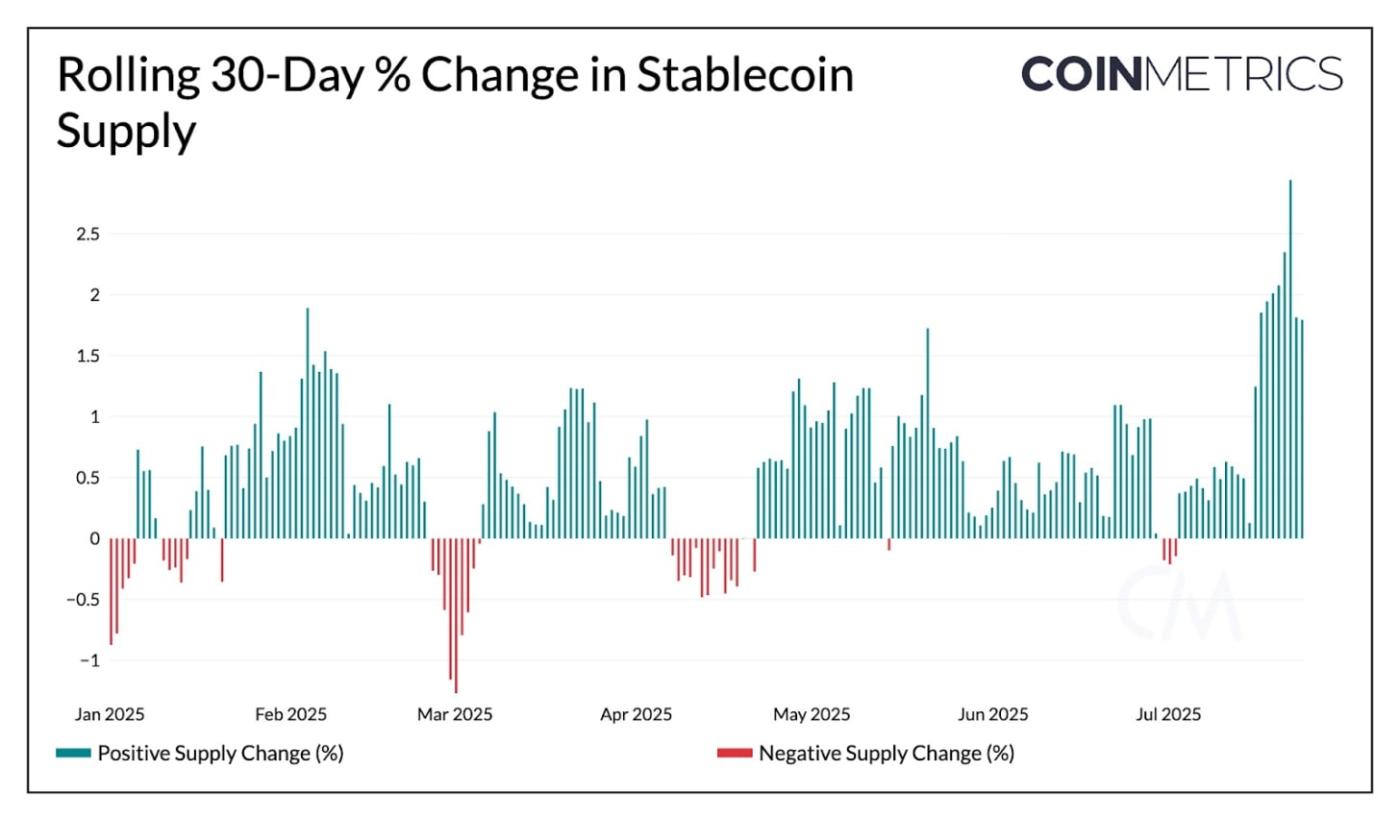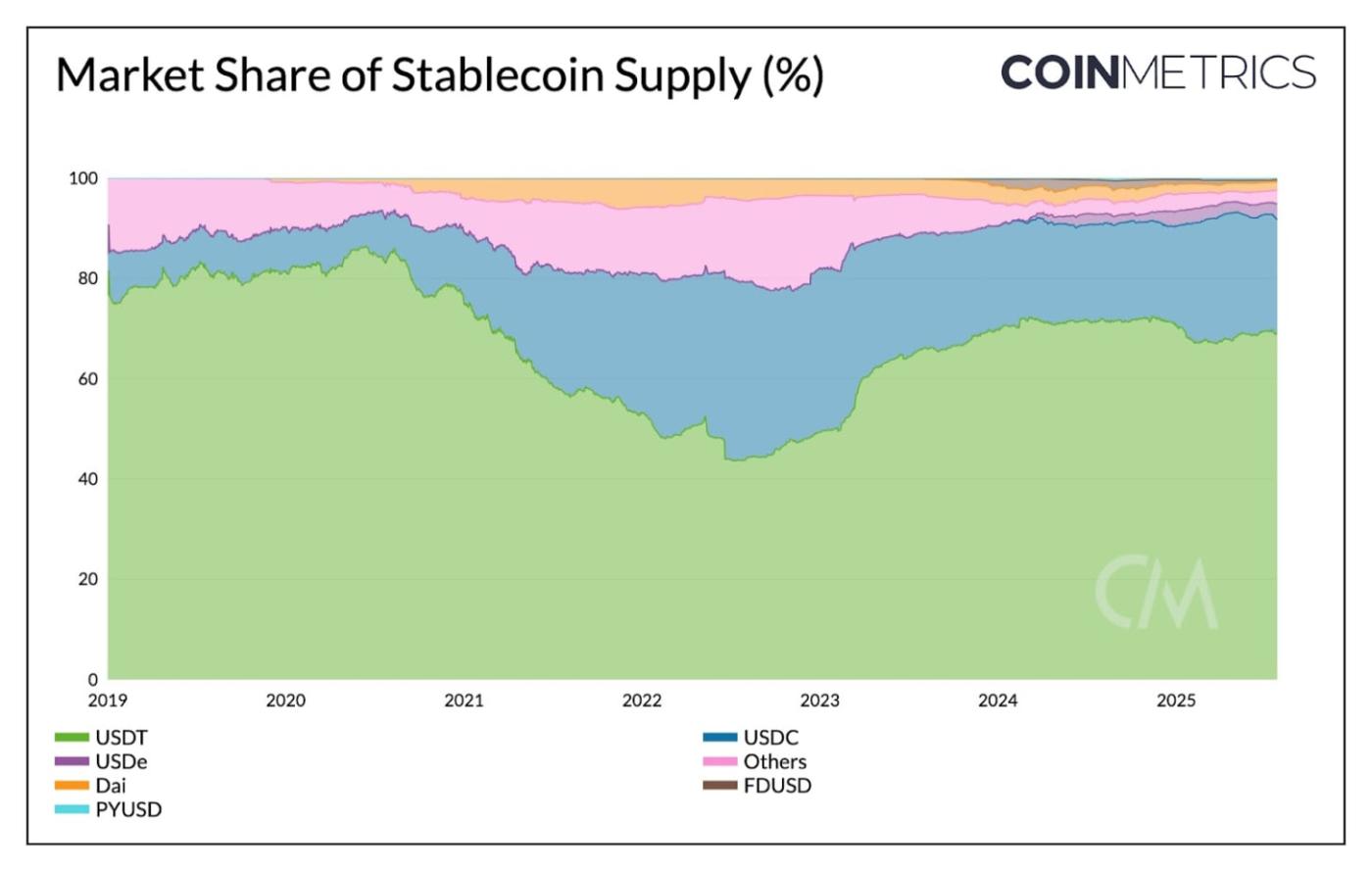Get the best data-driven crypto insights and analysis every week:
Thanks for reading Coin Metrics' State of the Network! Subscribe for free to receive new posts and support our work.
The Flows Behind the Crypto Market’s Rise to $4T
By: Tanay Ved
Key Takeaways:
Bitcoin’s realized cap surpassed $1T, reflecting deeper capital commitment and conviction across long-term holders as the crypto market cap approached $4T.
Demand for Bitcoin (BTC) and Ethereum (ETH) is outpacing new issuance, fueled by sustained spot ETF inflows and growing accumulation from corporate treasuries.
Market leadership is starting to broaden, with Ethereum gaining relative strength and altcoins like SOL and XRP seeing growing participation through rising spot trading volumes.
The GENIUS Act established the first U.S. federal framework for fiat-backed stablecoins, bringing regulatory clarity and setting the stage for increased participation and competition in the $250B+ stablecoin market.
Introduction
Digital asset markets approached the $4T mark for the first time, a major milestone in the industry’s growth. This latest leg higher can be attributed to a combination of structural and cyclical forces, from rising inflows into spot Bitcoin and Ethereum ETFs to accelerating accumulation by digital asset treasury companies and major regulatory breakthroughs like the passage of the GENIUS Act. The tailwinds behind crypto appear to be strengthening.
In this issue of Coin Metrics’ State of the Network, we break down the key market forces and on-chain flows propelling this phase of expansion.
Bitcoin’s Realized Cap Hits $1T, Market Activity Broadens
Bitcoin (BTC) reached a new all-time high of $123K, pushing its market cap to $2.38T and its realized capitalization, or the aggregate value of all bitcoins at the price when they last moved on the network, to over $1T. This reflects deeper capital commitment at elevated prices and highlights growing conviction in bitcoin’s role as a global asset amid sustained ETF demand and institutional interest.
Source: Coin Metrics Network Data Pro
Recent market activity suggests we may be in the early periods of broadening market leadership. Ethereum (ETH) has started to gain relative strength, with the ETH/BTC ratio bouncing 73% since May and ETH crossing $3900. This momentum is supported by record ETF inflows, growing corporate treasury adoption, and Ethereum’s position as a beneficiary of the GENIUS Act, given its sustained dominance in stablecoin activity.
Source: Coin Metrics Market Data Pro
This broadening is also reflected in spot trading volumes, which show renewed activity across ETH and large-cap altcoins like SOL and XRP. While BTC volumes remain strong, ETH and altcoin volumes have grown meaningfully in recent weeks. Bitcoin dominance also retreated to 59% as the market cap of altcoins approached $1.6T. Although early signs of broadening are evident, it remains to be seen whether this marks a sustained shift.
The table below provides a summary of market stats for tokens among the top 20 in market cap, excluding stablecoins and other on-chain derivatives:
Source: Coin Metrics Reference Rates & Market Data Pro
Demand Accelerates Through ETFs and Corporate Treasuries
A significant source of demand for BTC and ETH has been spot exchange traded funds (ETFs). After a slowdown in March and April, Bitcoin ETF flows regained momentum in May, pushing total holdings across U.S. spot ETFs to over 1.27M BTC (or 6.4% of total supply). BlackRock’s iShares Bitcoin Trust (IBIT) remains the largest issuer, with 735k BTC ($87B) held in the vehicle.
Source: Coin Metrics Network Data Pro, *Note: does not include Fidelity Wise Origin Bitcoin Fund (FBTC)
Ethereum (ETH) is now experiencing a similar surge in demand. Over the past few weeks, spot Ether ETFs have recorded a streak of net inflows, at times even outpacing those of Bitcoin. Total ETH held across ETFs has reached 5.8M ETH, or 4.8% of supply, with most of that growth occurring in recent months despite ETFs launching over a year ago.
Demand has also been supported by a growing cohort of Ether-focused corporate treasuries, helping ETH accumulation outpace new issuance. Unlike Bitcoin treasuries that primarily hold BTC as a passive asset, ETH treasuries are actively generating native yield through staking and DeFi, a model now extending to other large-cap token ecosystems like Solana (SOL), TRON (TRX), and Ethena (ENA).
On-Chain Holdings by Address Balance
Source: Coin Metrics Network Data Pro (BTC Supply by Address Balance & ETH Supply by Address Balance)
As seen in the charts above, BTC supply held by both small (<1 BTC) and large (1k–10k BTC) holders has gradually declined over the past year, suggesting a period of distribution as prices reach elevated levels. In contrast, ETH shows signs of renewed accumulation, particularly among large holders (10k–100k ETH), whose share of supply has recently climbed to over 22%. The supply held by small ETH holders (<1 ETH) has also increased, continuing a steady rise that began in 2021.
GENIUS Act and a New Era for Stablecoins
The GENIUS Act was signed into law on July 18, establishing the first federal framework for fiat-backed stablecoins in the U.S. This provides a level-playing field for stablecoin issuers, requiring fully backed reserves composed of low-risk, short-dated U.S. Treasuries and cash, regular audits, and licensing for issuers. Much like the approval of spot Bitcoin ETFs, the GENIUS Act promises to bring clarity and legitimacy to the stablecoin sector largely dominated by USD-pegged stablecoins.
Stablecoin supply growth has accelerated in recent weeks, as seen in the 30-day rolling supply change, with total supply now exceeding $255B.
Source: Coin Metrics Network Data Pro
This framework holds the potential to drive greater trust in fiat-backed stablecoins, lower the barrier to new entrants, and open the door to increased competition in payments. From existing issuers like Tether and Circle to potential entrants like regulated banks and fintechs, competition could help drive costs lower for consumers and businesses, while strengthening demand for the dollar.
Source: Coin Metrics Network Data Pro
Among current issuers, Circle and Paxos appear well positioned to meet the GENIUS Act’s requirements, as USDC and PayPal USD (PYUSD) already operate with full-reserve backing and regular attestations. Circle is actively pursuing a federal trust bank charter with the Office of the Comptroller (OCC) to achieve full GENIUS compliance and offer custody services to institutional customers. Other major issuers are also restructuring to align with the new law. Anchorage Digital, a federally chartered crypto bank, teamed up with Ethena Labs to issue USDtb through its stablecoin issuance platform. This makes Ethena’s USDtb one of the first fully GENIUS compliant stablecoins, with Anchorage providing federal oversight and reserve management. The model offers a “turnkey” solution for other projects aiming to remain active in the U.S. market.
Tether’s USDT, which accounts for ~68% of stablecoin supply, faces a more complex path. USDT has historically operated outside direct U.S. oversight, with reserves that include non-compliant assets like Bitcoin and precious metals. In response, Tether plans to launch a separate, U.S.-compliant stablecoin focused on institutional payments and interbank settlement. The new product will adhere to GENIUS Act standards, while the existing $162B USDT will continue to operate offshore, primarily serving emerging markets.
Stablecoin issuers have three years to comply with the GENIUS Act. After that, only GENIUS-compliant stablecoins can be supported by exchanges and custodians, giving issuers time to adapt to the new framework.
Conclusion
The market’s recent surge toward a $4T market cap reflects growing conviction across the asset class. Demand from ETFs and corporate treasuries continues to outpace new issuance, contributing to favorable supply dynamics across both BTC and ETH. Valuation metrics such as Bitcoin’s market value to realized value (MVRV) ratio suggest the market is not yet in overheated territory. While Bitcoin remains anchored by strong ETF inflows and long-term holders, market leadership is showing signs of broadening.
Additionally, the passage of the GENIUS Act marks a critical turning point for U.S. crypto regulation, offering clarity for stablecoins and paving the way for increased competition, and deeper integration into traditional finance. Despite the potential for short-term volatility, the combination of strong structural demand, improving regulatory clarity, and broadening participation points to continued strength ahead.
Coin Metrics Updates
This week’s updates from the Coin Metrics team:
Follow Coin Metrics’ State of the Market newsletter which contextualizes the week’s crypto market movements with concise commentary, rich visuals, and timely data.
As always, if you have any feedback or requests please let us know here.
Subscribe and Past Issues
Coin Metrics’ State of the Network, is an unbiased, weekly view of the crypto market informed by our own network (on-chain) and market data.
If you'd like to get State of the Network in your inbox, please subscribe here. You can see previous issues of State of the Network here.




